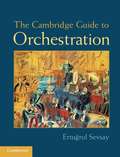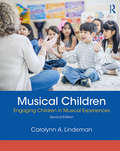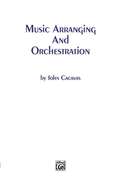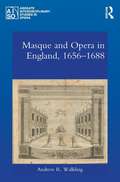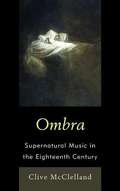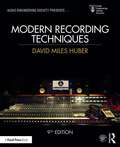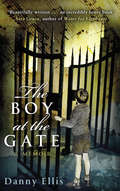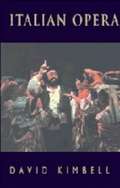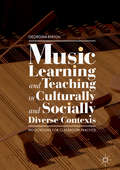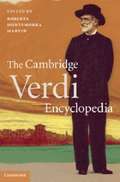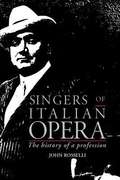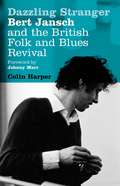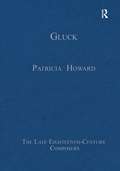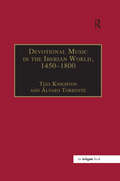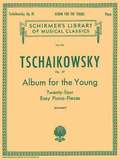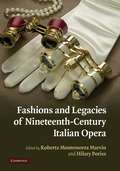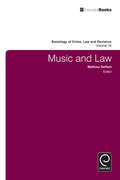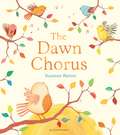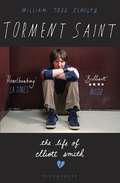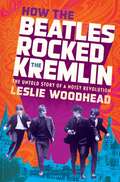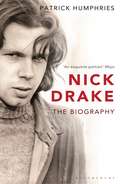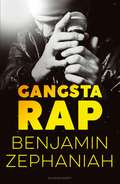- Table View
- List View
The Cambridge Guide to Orchestration (PDF)
by Ertugrul SevsayDemonstrating not only how to write for orchestra but also how to understand and enjoy a score, The Cambridge Guide to Orchestration is a theoretical and practical guide to instrumentation and orchestration for scholars, professionals and enthusiasts. With detailed information on all the instruments of the orchestra, both past and present, it combines discussion of both traditional and modern playing techniques to give the most complete overview of the subject. It contains fifty reduced scores to be re-orchestrated and a wide range of exercises, which clarify complex subjects such as multiple stops on stringed instruments, harmonics and trombone glissandi. Systematic analysis reveals the orchestration techniques used in original scores, including seven twentieth-century compositions. This Guide also includes tables and lists for quick reference, providing the ranges of commonly used instruments and the musical names and terminology used in English, German, Italian and French.
Musical Children: Engaging Children in Musical Experiences
by Carolynn LindemanMusical Children: Engaging Children in Musical Experiences, Second Edition, is designed for students majoring in early childhood or elementary education, or music education. It highlights the important role music plays in a child’s education and life, offering a practical resource for bringing together music and young children during these important early years. Thirty-seven engaging musical experiences help pre-service and in-service teachers—some who may only have a limited background in music—learn how to make music a part of their students’ daily lives, with strategies that are ideal both in and out of the classroom. Musical Children is an invaluable guide to assist teachers in engaging children in meaningful, joyful, and playful musical experiences. NEW to the second edition: The 2014 National Core Music Standards Updated and expanded prekindergarten chapter Greater focus on music fundamentals Expansion of Dalcroze, Orff, Kodály, and Music Learning Theory approaches Discussion questions and projects for each chapter Addition of an Autoharp®, Chromaharp®, and QChord® instructional unit All 49 audio tracks from the musical experiences now available for online listening, hosted or linked to popular music streaming services A new companion website is home to numerous resources, including all audio files, supplementary notated songs, charts for instrument study, and information on IDEA and children with disabilities.
Music Arranging And Orchestration
by John CacavasOrchestrating is a highly complex technique and to many, even those with academic training, a mystery fraught with a labyrinth of hazards. What is required, along with innate talent and general musicality, is the practical "know how." This is hard to achieve without actual professional experience and contact with "live" orchestras. To this end, John Cacavas contributes his extensive experience and ability with a practical approach to the practical problems of orchestrating. It is in this context most orchestrators must function, and to whom this book should be of benefit. The author has been a "musical activist" in all the varied aspects of instrumental combination from the "classical" to the "contemporary," and in the diverse application of his skills in all the media that utilize music and "orchestrations."
Masque And Opera In Restoration England (PDF)
by Andrew R. WalklingMasque and Opera in England, 1656–1688 presents a comprehensive study of the development of court masque and through-composed opera in England from the mid-1650s to the Revolution of 1688–89. In seeking to address the problem of generic categorization within a highly fragmentary corpus for which a limited amount of documentation survives, Walkling argues that our understanding of the distinctions between masque and opera must be premised upon a thorough knowledge of theatrical context and performance circumstances. Using extensive archival and literary evidence, detailed textual readings, rigorous tabular analysis, and meticulous collation of bibliographical and musical sources, this interdisciplinary study offers a host of new insights into a body of work that has long been of interest to musicologists, theatre historians, literary scholars and historians of Restoration court and political culture, but which has hitherto been imperfectly understood. A companion volume will explore the phenomenon of "dramatick opera" and its precursors on London’s public stages between the early 1660s and the first decade of the eighteenth century.
Masque And Opera In Restoration England
by Andrew R. WalklingMasque and Opera in England, 1656–1688 presents a comprehensive study of the development of court masque and through-composed opera in England from the mid-1650s to the Revolution of 1688–89. In seeking to address the problem of generic categorization within a highly fragmentary corpus for which a limited amount of documentation survives, Walkling argues that our understanding of the distinctions between masque and opera must be premised upon a thorough knowledge of theatrical context and performance circumstances. Using extensive archival and literary evidence, detailed textual readings, rigorous tabular analysis, and meticulous collation of bibliographical and musical sources, this interdisciplinary study offers a host of new insights into a body of work that has long been of interest to musicologists, theatre historians, literary scholars and historians of Restoration court and political culture, but which has hitherto been imperfectly understood. A companion volume will explore the phenomenon of "dramatick opera" and its precursors on London’s public stages between the early 1660s and the first decade of the eighteenth century.
Ombra: Supernatural Music In The Eighteenth Century (PDF)
by Clive McClellandOmbra is the musical language employed when a composer wishes to inspire awe and terror in an audience. Clive McClelland's Ombra: Supernatural Music in the Eighteenth Century explores the large repertoire of such music, focusing on the eighteenth century and Mozart in particular. He discusses a wide range of examples drawn from theatrical and sacred music, eventually drawing parallels between these features and Edmund Burke's 'sublime of terror,' thus placing ombra music in an important position in the context of eighteenth-century aesthetic theory.
Modern Recording Techniques (Audio Engineering Society Presents Series (PDF))
by David Miles Huber Robert E. RunsteinModern Recording Techniques is the bestselling, authoritative guide to sound and music recording. Whether you’re just starting out or are looking for a step-up in the industry, Modern Recording Techniques provides an in-depth read on the art and technologies of music production. It’s a must-have reference for all audio bookshelves. Using its familiar and accessible writing style, this ninth edition has been fully updated, presenting the latest production technologies and includes an in-depth coverage of the DAW, networked audio, MIDI, signal processing and much more. A robust companion website features video tutorials, web-links, an online glossary, flashcards, and a link to the author’s blog. Instructor resources include a test bank and an instructor’s manual. The ninth edition includes: Updated tips, tricks and insights for getting the best out of your studio An introduction to the Apple iOS in music production Introductions to new technologies and important retro studio techniques The latest advancements in DAW systems, signal processing, mixing and mastering
The Boy at the Gate: A Memoir
by Danny EllisDanny Ellis was a survivor, strong and resilient. A successful singer/songwriter, he was proud of the way he’d ‘handled’ his painful past: the grinding poverty of the 1950s Dublin slums, and the brutality of the orphanage, the notorious Artane Industrial School where he was left. He’d safely buried it. Or so he thought.Then one night, while writing a powerful song that would launch his acclaimed album, 800 Voices, his past came flooding back to haunt him. Long-forgotten memories of betrayal and abandonment burst forth in a shocking revelation: his eight-year-old self was still lost in the orphanage.Although badly shaken, Danny began a courageous journey that would lead him back to the streets of Dublin, to the tenement slums and, eventually, to the brutality and scallywag shenanigans of the Artane playground. What he found with each twist and turn of his odyssey would change his life for ever.The Boy at the Gate is a poignant, profoundly moving memoir of forgiveness and redemption, and an inspiring testament to the healing power of music and love.
Italian Opera (PDF)
by David KimbellItaly was the birthplace of opera. In this authoritative and accessible account of Italian opera, David Kimbell introduces the composers and dramatists, the singers and audiences who, over three hundred years, have created not only a national tradition but the central tradition from which others have drawn their inspiration. He traces the history of Italian opera from its origins in the humanism of the Renaissance to Puccini in the early twentieth century, drawing attention not only to musical issues but also to the social, literary, and philosophical ideas that have shaped modern Italian civilisation. Each part is illustrated by a detailed critical discussion of a key work.
Music Learning and Teaching in Culturally and Socially Diverse Contexts: Implications for Classroom Practice
by Georgina BartonThis book examines the inter-relationship between music learning and teaching, and culture and society: a relationship that is crucial to comprehend in today’s classrooms. The author presents case studies from diverse music learning and teaching contexts – including South India and Australia and online learning environments – to compare the modes of transmission teachers use to share their music knowledge and skills. It is imperative to understand the ways in which culture and society can in fact influence music teachers’ beliefs and experiences: and in understanding, there is potential to improve intercultural approaches to music education more generally. In increasingly diverse schools, the author highlights the need for culturally appropriate approaches to music planning, assessment and curricula. Thus, music teachers and learners will be able to understand the diversity of music education, and be encouraged to embrace a variety of methods and approaches in their own teaching. This inspiring book will be of interest and value to all those involved in teaching and learning music in various contexts.
Music Learning and Teaching in Culturally and Socially Diverse Contexts: Implications for Classroom Practice
by Georgina BartonThis book examines the inter-relationship between music learning and teaching, and culture and society: a relationship that is crucial to comprehend in today’s classrooms. The author presents case studies from diverse music learning and teaching contexts – including South India and Australia and online learning environments – to compare the modes of transmission teachers use to share their music knowledge and skills. It is imperative to understand the ways in which culture and society can in fact influence music teachers’ beliefs and experiences: and in understanding, there is potential to improve intercultural approaches to music education more generally. In increasingly diverse schools, the author highlights the need for culturally appropriate approaches to music planning, assessment and curricula. Thus, music teachers and learners will be able to understand the diversity of music education, and be encouraged to embrace a variety of methods and approaches in their own teaching. This inspiring book will be of interest and value to all those involved in teaching and learning music in various contexts.
The Cambridge Verdi Encyclopedia (PDF)
by Edited by Roberta Montemorra MarvinVerdi’s enduring presence on the opera stages of the world and as a subject for study by scholars in various disciplines has placed him as a central figure within modern culture. His operas, including La traviata, Rigoletto, and Aida, are among the most frequently performed worldwide and his popularity from the mid-nineteenth century to the present day is undisputed. The Cambridge Verdi Encyclopedia covers aspects of Verdi’s life, his music, and his world. Appendices list Verdi’s known works, both published and unpublished, the characters in his operas and the singers who created them, and a chronology of his life. As a starting point for information on specific works, people, places, and concepts associated with Verdi, the Encyclopedia reflects the very latest scholarship, presented by an international array of experts, and will have a broad appeal for opera-lovers, students, and scholars.
Singers of Italian Opera: The History of a Profession (PDF)
by John RosselliJohn Rosselli's wide-ranging study introduces all those singers, members of the chorus as well as stars, who have sung Italian opera from 1600 to the present. Where did they come from? How were they trained? What did they earn, and what pressures shaped their careers? Singers are shown slowly emancipating themselves from dependence on great patrons and entering the dangerous freedom of the market. The castrati who dominated eighteenth-century opera turn out to be more conscientious and professional than their previous reputation as extravagant, vain creatures has suggested. The book examines the sexist prejudices against them and against women singers - who in the early days of opera were presumed to be courtesans and sometimes were. But for women, opera provided one of the very few professional and economic opportunities.
Dazzling Stranger: Bert Jansch And The British Folk And Blues Revival
by Colin HarperThe guitarists' guitarist and the songwriters' songwriter, the legendary Bert Jansch has influenced stars as diverse as Jimi Hendrix, Jimmy Page, Paul Simon, Sandy Denny, Nick Drake, Donovan, Pete Townshend, Neil Young, Bernard Butler, Beth Orton and Laura Marling. Unassuming, enigmatic and completely focused on his music until his death in October 2011, he remained singularly resilient to the vagaries of fashion, being rediscovered and revered by new generations of artists every few years. Born in Edinburgh in 1943, Jansch became an inspirational and pioneering figure during Britain's 'folk revival' of the 1960s. In 1967 he formed folk/jazz fusion band Pentangle with John Renbourn and enjoyed international success until they split in 1973, when he returned to a solo career. In Dazzling Stranger, Colin Harper looks at the career Jansch enjoyed, which has secured his standing as one of the true originals of British music.
Gluck (The\late Eighteenth-century Composers Ser. (PDF))
by Patricia HowardThis volume presents a collection of essays by leading Gluck scholars which highlight the best of recent and classic contributions to Gluck scholarship, many of which are now difficult to access. Tracing Gluck’s life, career and legacy, the essays offer a variety of approaches to the major issues and controversies surrounding the composer and his works and range from the degree to which reform elements are apparent in his early operas to his contribution to changing perceptions of Hellenism. The introduction identifies the major topics investigated and highlights the innovatory nature of many of the approaches, particularly those which address perceptions of the composer in the nineteenth and twentieth centuries. This volume, which focuses on one of the most fascinating and influential composers of his era, provides an indispensable resource for academics, scholars and libraries.
Gluck (The\late Eighteenth-century Composers Ser. (PDF))
by Patricia HowardThis volume presents a collection of essays by leading Gluck scholars which highlight the best of recent and classic contributions to Gluck scholarship, many of which are now difficult to access. Tracing Gluck’s life, career and legacy, the essays offer a variety of approaches to the major issues and controversies surrounding the composer and his works and range from the degree to which reform elements are apparent in his early operas to his contribution to changing perceptions of Hellenism. The introduction identifies the major topics investigated and highlights the innovatory nature of many of the approaches, particularly those which address perceptions of the composer in the nineteenth and twentieth centuries. This volume, which focuses on one of the most fascinating and influential composers of his era, provides an indispensable resource for academics, scholars and libraries.
Devotional Music In The Iberian World, 1450-1800: The Villancico And Related Genres
by Álvaro Torrente Tess KnightonFrom the fifteenth century to the beginning of the nineteenth century, devotional music played a fundamental role in the Iberian world. Songs in the vernacular, usually referred to by the generic name of 'villancico', but including forms as varied as madrigals, ensaladas, tonos, cantatas or even oratorios, were regularly performed at many religious feasts in major churches, royal and private chapels, convents and in monasteries. These compositions appear to have progressively fulfilled or supplemented the role occupied by the Latin motet in other countries and, as they were often composed anew for each celebration, the surviving sources vastly outnumber those of Latin compositions; they can be counted in tens of thousands. The close relationship with secular genres, both musical, literary and performative, turned these compositions into a major vehicle for dissemination of vernacular styles throughout the Iberian world. This model of musical production was also cultivated in Portugal and rapidly exported to the Spanish and Portuguese colonies in America and Asia. In many cases, the villancico repertory represents the oldest surviving source of music produced in these regions, thus affording it a primary role in the construction of national identities. The sixteen essays in this volume explore the development of devotional music in the Iberian world in this period, providing the first broad-based survey of this important genre.
Album For The Young: Op. 39; 24 Easy Pieces (PDF)
by Pyotr Il'Yich Tchaikovsky A. RuthardtAlbum For The Young
Fashions and Legacies of Nineteenth-Century Italian Opera (PDF)
by Edited by Roberta M. Marvin Hilary PorissOperatic works by Italian composers of the nineteenth century have undergone countless transformations since their premieres, shifting shape in response to a variety of new geographic, temporal, technological, and performative contexts. These enduring works by Rossini, Donizetti, Bellini, Verdi, Puccini, and their contemporaries have myriad stories to tell. Fashions and Legacies reconstructs a selection of these stories, exploring ways in which operatic works have been reshaped and revived throughout the nineteenth, twentieth, and twenty-first centuries. While focusing on how these works have been altered, the twelve contributors in this book also respond to fundamental questions: how has this music retained – or sacrificed – its powerful messages in the face of deconstruction and recontextualization over time and place? What happens to these operas once they have escaped control of their authors? The contributions of singers, stage directors, conductors, and other theatrical personalities stand front and center of the volume.
Music and Law (Sociology of Crime, Law and Deviance #18)
by Mathieu DeflemThis volume deals with various social-science perspectives on law and legal control pertaining to music in a variety of contexts. Under influence of important recent social developments, especially in the realm of communications technology, the world of music has been changing very rapidly and profoundly these past decades. As a result, the world of music, especially popular music, has been subject to a range of new legal issues. This volume brings together some 15 scholars to contribute their respective chapters on the socio-legal aspects involved in music as a social reality. The chapters address various pertinent questions from the perspective of socio-legal studies, sociology of law, jurisprudence, and related social and behavioral sciences. The issues addressed can range from matters of formal law and legislation to law-related behavior, deviance, and informal normative structures and processes that have a relevance to music, whether in a contemporary or historical setting. Thematically diverse within the province of the social and behavioral sciences related to law, the chapters in this volume are not restricted in terms of theoretical approach and methodological orientation.
The Dawn Chorus
by Suzanne BartonPeep awakes one morning to the sound of a beautiful song - but where is it coming from?It's the Dawn Chorus! And Peep is desperate to sing with them. But no matter how hard he tries, he just can't make it happen. Little does Peep know, he's just about to meet someone very special who will show him just how enchanting nightingales like him can be . . .A heartfelt story, exceptionally illustrated by exciting new author-illustrator Suzanne Barton.
Torment Saint: The Life of Elliott Smith
by William Todd SchultzElliott Smith was one of the most gifted songwriters of the nineties, adored by worshipful fans for his subtly melancholic words and melodies. The sadness had its sources in the life. There was trauma from an early age, years of drug abuse and a chronic sense of disconnection that sometimes seemed almost self-engineered. Smith died violently in Los Angeles in 2003, under what some believe to be questionable circumstances, of a single fatal stab wound to the chest. By this time fame had found him, and record buyers who shared the listening experience felt he spoke directly to them from beyond: lonely, lovelorn, frustrated, fighting until he could fight no more. And yet, although his achingly intimate lyrics carried the weight of truth, Smith remained unknowable. In Torment Saint, William Todd Schultz gives us the first proper biography of the rock star, a decade after his death, imbued with affection, authority, sensitivity and long-awaited clarity.Torment Saint draws on Schultz's careful, deeply knowledgeable readings and insights, as well as on more than 150 hours of interviews with close friends, lovers, bandmates, peers, managers, label owners, and recording engineers and producers. This book unravels the remaining mysteries of Smith's life and his shocking, too-early end. It will be an indispensable examination of his life and legacy, both for Smith's legions of fans as well as readers still discovering his songbook.
How the Beatles Rocked the Kremlin: The Untold Story of a Noisy Revolution
by Leslie WoodheadImagine a world where Beatlemania was against the law-recordings scratched onto medical X-rays, merchant sailors bringing home contraband LPs, spotty broadcasts taped from western AM radio late in the night. This was no fantasy world populated by Blue Meanies but the USSR, where a vast nation of music fans risked repression to hear the defining band of the British Invasion.The music of John, Paul, George, and Ringo played a part in waking up an entire generation of Soviet youth, opening their eyes to seventy years of bland official culture and rigid authoritarianism. Soviet leaders had suppressed most Western popular music since the days of jazz, but the Beatles and the bands they inspired-both in the West and in Russia-battered down the walls of state culture. Leslie Woodhead's How The Beatles Rocked the Kremlin tells the unforgettable-and endearingly odd-story of Russians who discovered that all you need is Beatles. By stealth, by way of whispers, through the illicit late night broadcasts on Radio Luxembourg, the Soviet Beatles kids tuned in. "Bitles," they whispered, "Yeah, Yeah, Yeah."
Nick Drake: The Biography
by Patrick HumphriesNick Drake was barely 26 years old when he died in 1974. The British singer-songwriter made only three albums during his short life time: "Five Leaves Left", "Bryter Layer" and "Pink Moon". All are now recognized as classics.;Since his death, Nick has been cited as a seminal influence by stars as diverse as REM, Elton John, Paul Weller, Jackson Brown, Everything But the Girl, Tom Verlaine and Matt Johnson of The The.;This biography includes extensive interviews with friends, colleagues and musicians who knew and worked with Nick. It provides an insight into the life and work of Nick Drake, and also the music scene of the 1960s that formed his backdrop.;The author's lifelong appreciations of and interest in Nick Drake were further fuelled when he discovered that his uncle Dr James Lusk actually delivered Nick into the world and remained a friend of the Drake family. In the book, he draws on a long letter from Nick's father to Dr Lusk, in which he describes how Nick's mother, discovered Nick's body during the morning of 25 November 1974, following an accidental overdose of prescribed drugs.
Gangsta Rap (New Windmills Ks3 Ser.)
by Mr Benjamin ZephaniahJust what do you do with talent from the wrong side of town? Benjamin Zephaniah draws on his own experiences with school and the music business to create a novel that speaks with passion and immediacy about the rap scene.Ray has trouble at home, and he has trouble at school – until he's permanently excluded and ends up sleeping on the floor of a record shop. What happens to a boy like Ray? If he's lucky, maybe he gets a chance to shine.The story of three boys who aren't easy. They don't fit in. They seem to attract trouble. But they know what they want, and they've got the talent to back it up ...Brilliantly written and with a real ear for dialogue, fans of Angie Thomas and Malorie Blackman will love Benjamin Zephaniah's novels for young adult readers: Refugee BoyFaceGangsta RapTeacher's Dead
